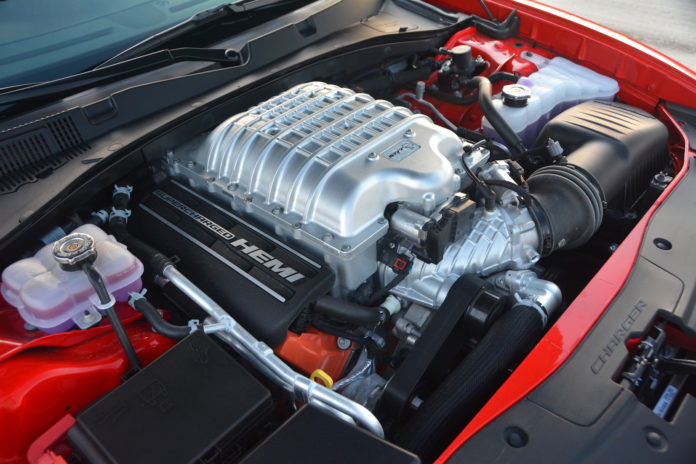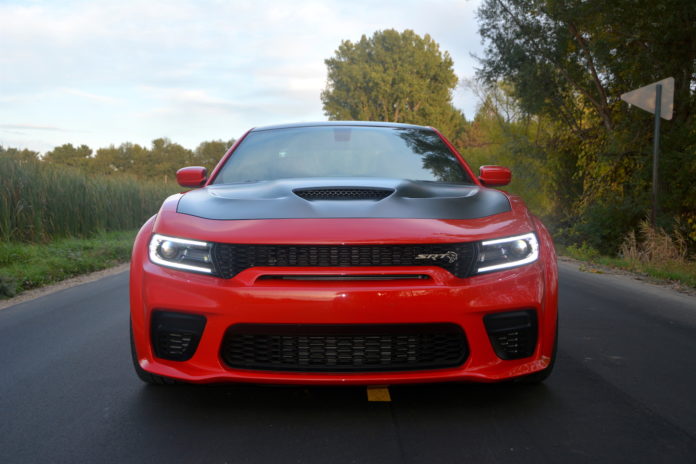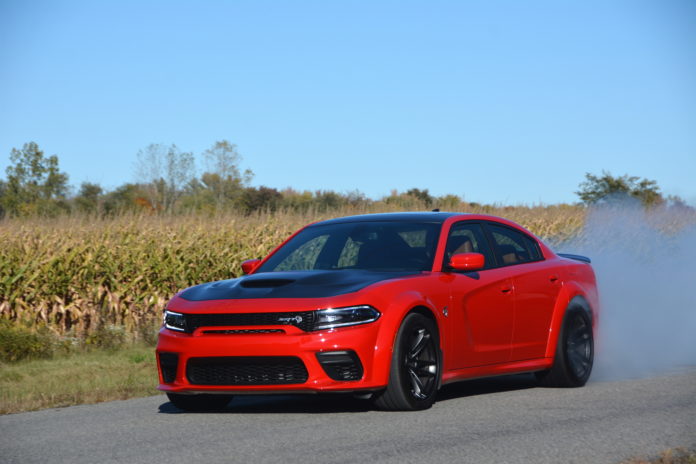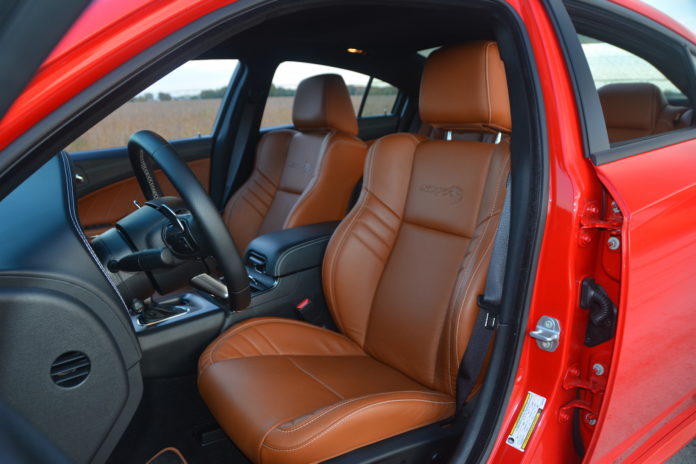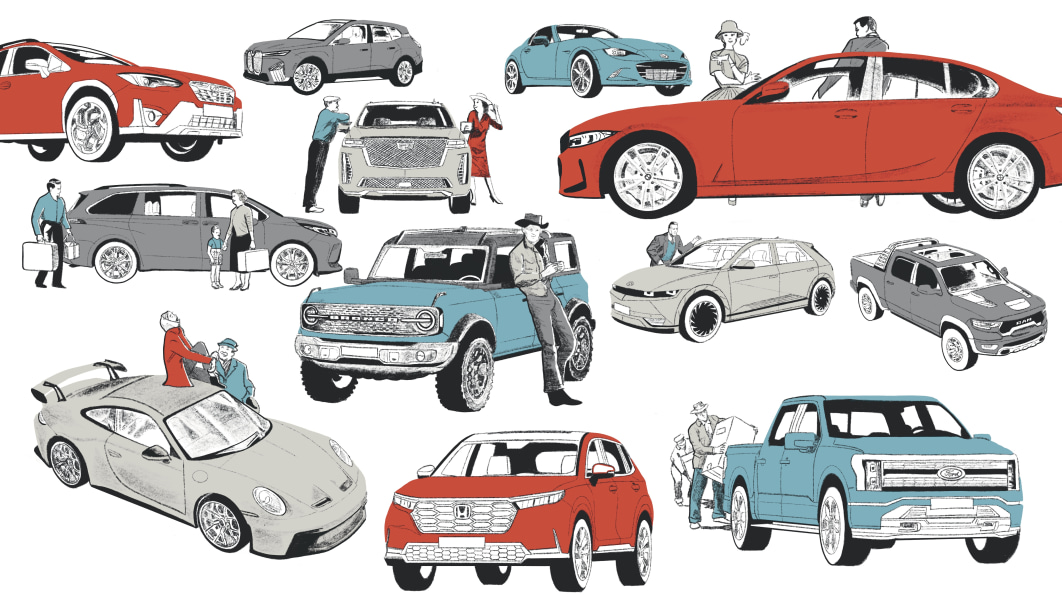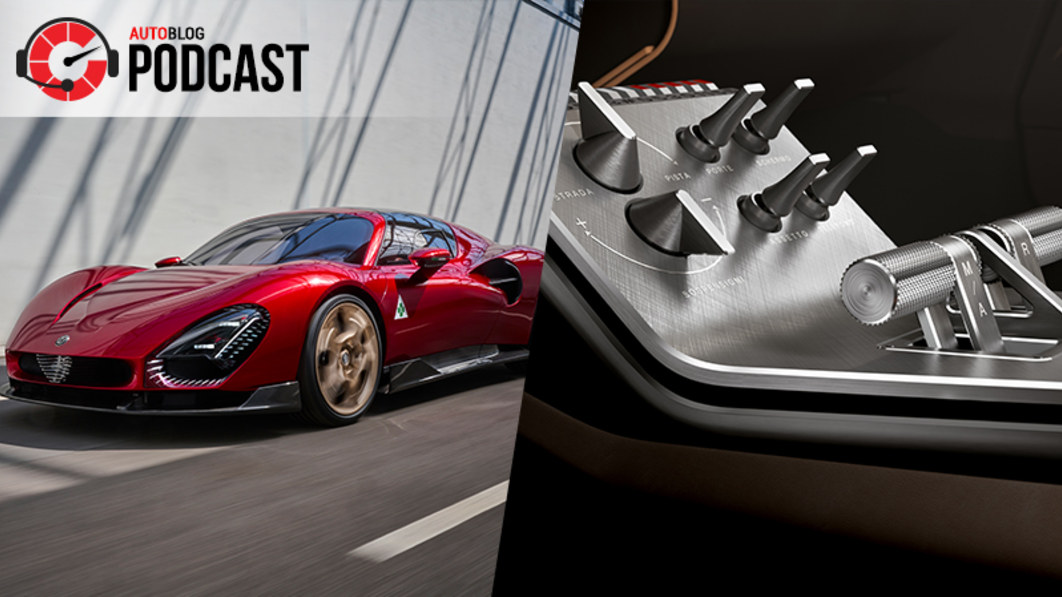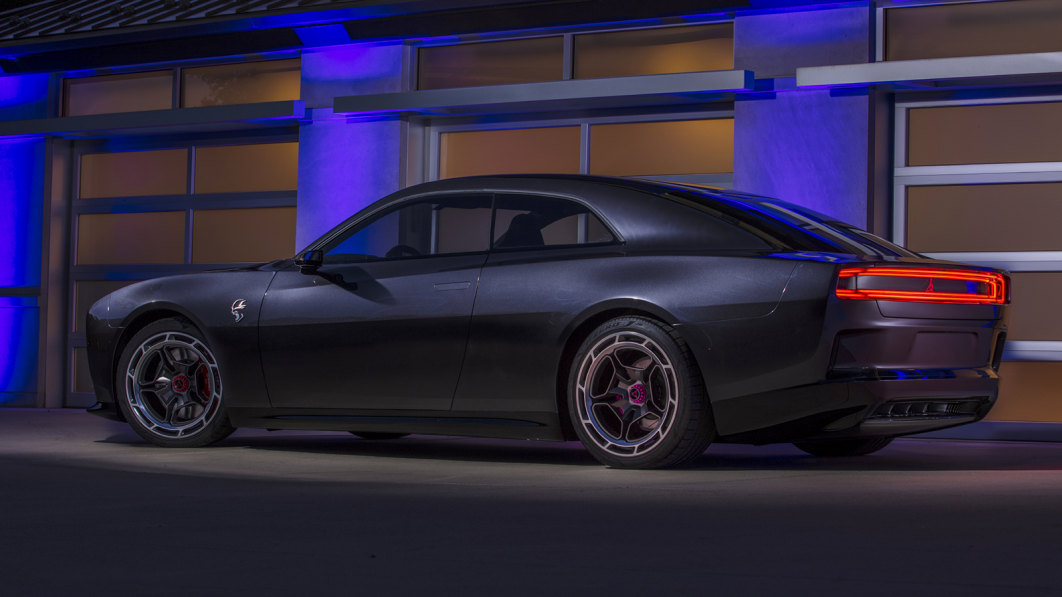2020 has been a weird year. No one will argue that. And when things get a little too weird, you seek out things that bring you joy, things that bring you hope, and things that put a smile on your face. Things like classic Americana. Like muscle cars – big cars, big engines, big fun. So after a season of “sensible cars” we reached out to Dodge to see what flavor of Hellcat they were serving up this Autumn. The Durango Hellcat wasn’t available yet, but they offered us a Charger SRT Hellcat Widebody instead. The only thing we knew about it was that it had big ol’ fender flares around the wheel wells and manages to look even meaner than the standard Charger SRT Hellcat. We’d give it a shakedown.
The last Charger Hellcat we tested was two years ago. It was big. It was comfortable. It was loud. It looked mean. And it went like hell. We loved it and we laid burned rubber every opportunity we got. All the roads around our office had twin black squiggly stripes on them. Some short, some almost 100 yards long. It was a riot on wheels. So we were looking forward to driving the ol’ girl again.
The day it showed up, we heard it before we saw it. We knew it was arriving by the engine sound…a half-mile away. The unmistakable deep rumble of the engine through the exhaust pipes was audible from a literal half-mile away. Think about that. The driver wasn’t revving the engine, nor was he squealing the tires. He was simply driving it conservatively (don’t ask me how). The hair on the back of my neck stood up. As it pulled into view, my knees went a little weak. The TorRed (get it?) colored car with matte black hood, roof, and trunk looked amazing and the fender flares made it look incredibly aggressive. The curves of the myriad scoops and grilles and flares gave it a menacing appearance. The matte black wheels finished off the look nicely.
The interior is very straightforward. It’s basic but plush and comfortable. It is a mixture of black leather, caramel colored leather, carbon fiber, and chrome. It was a very comfortable-looking interior and we were not disappointed in that analysis. With a spacious interior and soft seats and surfaces, it proved to be an excellent cockpit from which to pilot the Hellcat, allowing long drives in maximum comfort and sporting drives in well-bolstered stability. Perfect for every Midwestern season, it comes with 10-way electrically adjustable heated seats (both front and rear) and steering wheel. The seats are also ventilated for summer comfort as well. If you can’t get comfortable in this car, you have a serious medical condition. The gauges are a blend of analog and digital. And who doesn’t love a car with a 200-mph speedometer. I was told it’ll make good use of most of that speedometer too, but we didn’t push it anywhere close to that. We like having a drivers license, thank you very much.
The 6.2L supercharged Hemi V8 feels relatively unchanged from our first experience with it. It still makes gobs of torque and horsepower and sounds like a million-bucks. Endowed with 707 hp (!) and 650 lb-ft of torque, it can move the heavy car to 60mph in about 3.6 seconds and keep on scaring the crap out of you all the way to 196 mph. The quarter-mile comes in 10+ seconds. Acceleration in this car literally confuses your brain the first few times you launch it.
With great power comes great responsibility, so Dodge wisely fitted massive Brembo 6-piston brake calipers and dinner plate-sized vented disks to arrest that speed. They slow the nearly 2.5-ton car as quickly and easily as any lighter sport sedan. Pedal feedback is excellent and allows you to modulate the brakes in a simple, straightforward way.
The transmission is an 8-speed automatic, but offers paddle shifters behind the steering wheel. They’re much more responsive than you’d expect. While big horsepower cars like the Charger Hellcat usually respond better to letting the automatic transmission do it’s thing, In Track mode, I felt they really complemented the driving experience. It was also nice to be able to downshift approaching a stop light and listen to that Hellcat engine growl.
Since our last outing with a Charger Hellcat, Dodge has added a few features that make it easier to extract more performance. To complement their launch control, they’ve included a feature called “Line Lock.” If you engage Line Lock, it electronically disengages the rear brake lines, allowing you to step on the brake pedal and only lock the front brakes so you can send maximum power to the rear wheels for more effective launches. Launch control is still available, allowing you to dial up a pre-set rpm level for launch. A new “after run chiller” cools the engine after a workout.
The big draw though, is what comes standard as part of the Widebody option: an improved suspension that gives the car much improved handling. The Widebody Hellcat isn’t just a body change that makes it look cooler and allows wider tires under the fenders. No, it’s really more about the suspension that wheels are connected to. Two years ago when we first drove the standard Charger Hellcat, we found the suspension to be too soft. It was floaty and uninspiring, leaning heavily in corners. It was electronically adjustable though, and switching from Normal to Sport or Track firmed things up, but the base setting was much, much too soft. Even in Sport or Track modes, it was still softer than we liked.
The new Widebody performance adaptive suspension is very firm in Normal mode and feels much more competent right out of the gate. Switch it to Sport mode and it firms up a bit and turns traction control completely off. This is also known as “Burn-the-Tires-Off” mode. This mode really allows you to be a complete hooligan and really play with the car, drifting through roundabouts in smoky lurid drifts. Switch it to Track mode and the traction control returns enough to provide the maximum balance of slip and grip to make the Charger Hellcat Widebody a track-devouring animal. The shock setting on Track is too harsh for everyday roads unless you’re hardcore though. We usually left it in Normal unless we felt like signing our names in rubber paint.
On a winding back country road, in any mode, the Hellcat Widebody just wants to run. It’s suspension is unperturbed by bumps and dips and uneven spots; it stays balanced and controlled and just wants to go faster. On the freeway, it’s comfortable and fast and unflappable. Cloverleaf on-ramps are no challenge – the Charger Hellcat Widebody just rockets around them and allows you to shoot into traffic with surprising ease. This is really the WHOLE package. This isn’t just a one-trick pony muscle car, but a balanced performance car that’s at home on the road and on the track.
And the whole time you’re burning up the tires and terrorizing the freeways, you sit in an airy, spacious cabin enjoying the comforts of the cockpit. The smell of the leather seats mixed with the acrid smell of burnt rubber soothes you. The climate control keeps temps at a comfortable spot. The fantastic stereo cranks out one AC/DC tune after another. And the cupholder holds your 32-ounce pop tightly while you drift the car sideways through yet another corner.
The Hellcat engine may be Chrysler’s greatest gift to the world, but the rest of the car provides a marvelous platform to exhibit it’s abilities in. It’s just about perfect. Are there any flaws? Not really. Everything worked perfectly, as expected. Would we change anything about the car? My first thought is to shrink it down in size, but truthfully I loved the enormity of the car. I’m the guy that usually seeks out the smallest car possible to drive, but I loved the sheer size and heft of this car and the fact that DESPITE that size and heft, it still launches harder than an F/A-18 off a carrier deck. The size also adds an intimidation factor. Nobody wants to mess with the 900-lb gorilla.
If it has a flaw it’s fuel consumption. Fuel consumption is lousy, as you’d expect. There’s a price to be paid for all that fun. But it’s completely worth it. The EPA estimates that you’ll get 12 mpg in the city and 21 mpg on the highway for a combined estimate of 15 mpg. We actually averaged better than that, getting a combined average of 18.5 mpg. Which is pretty darned good for a 707 hp, 2-1/2 ton car.
The base price of the Charger SRT Hellcat Widebody is about $73,000 USD. That’s a pretty reasonable price for such a big comfortable performance rocket like the Hellcat. Our car came in at $85,000 USD with all the various options but it’d be fairly easy to keep the price closer to base if you were so inclined. None of the options on the car were essential, though that Harmon-Kardon stereo system was pretty kick-ass.
It’s amazing to us that for as long as the Charger has been on the market, it neither feels old nor outdated. Dodge does an excellent job keeping it updated and keeping it immensely fun. As long as they keep improving it and expanding the legend, it’ll always keep us wanting more.

